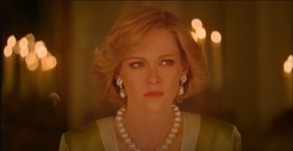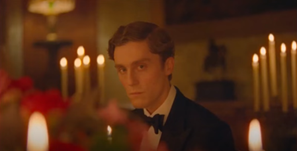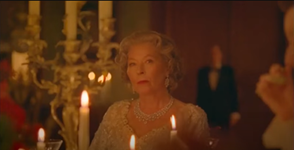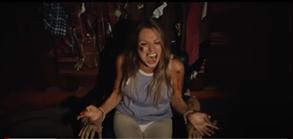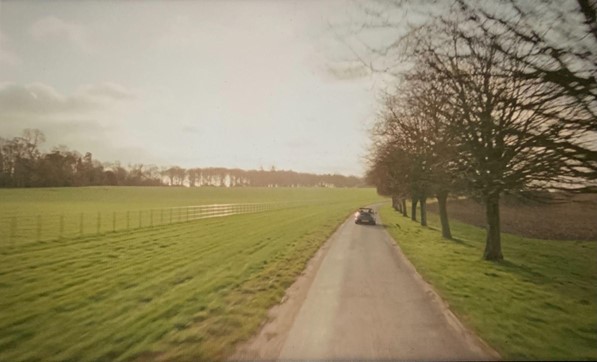
From director Pablo Larrain, Spencer (2021) was long awaited as the ultimate biopic on one of the most fascinating, yet cursed, personalities of modern history. The story of Lady Diana has been an object of attention since the very beginning of her relationship with Prince Charles and her entry into the royal family. Her figure has always had two sides, which only began to be comprehended appropriately after her death, and whose comprehension also brought to light some of the controversies of the royal institution. Season four and five of Netflix’s The Crown give one accurate representation of both these aspects. The show introduces Diana as a 16-year-old girl, who falls in love with Prince Charles and idealizes royal life as a dream. However, the series moves quickly from this idyllic view to the claustrophobic reality of life within the royal family. The progressive decay of Diana’s mental health takes place quite fast, as she tries to meet the standards required to live as a “royal,” while experiencing a growing sense of loneliness in a relationship where love only exists for the eyes of the public. If The Crown does a good job at giving a nuanced depiction of Diana, the princess’ point of view is one among many, in a show where all characters are equally portrayed in their merits and flaws, to stimulate empathy and understanding from the audience. Larrain’s Spencer takes a different approach by presenting facts from Diana’s perspective only, a character immersion which involves interesting choices in terms of style and genre. In fact, if Spencer was categorized as “drama,” this article will argue that the category is not as fitting as it may be for The Crown. Instead, Larrain’s film presents multiple elements which belong to the horror genre. In a graceful envelope of elegant dresses, luxurious meals and beautiful landscapes, Spencer depicts the psychological suffering of a princess kept in a golden cage. Besides audiovisual features which are typically horror, it also presents parallels with two classics of the horror genre: Stanley Kubrick’s The Shining (1980), and Tobe Hooper’s The Texas Chain Saw Massacre (1974). The comparison concerns plot development as well as stylistic choices in terms of cinematography and action sequences. As it states at the beginning, Spencer is “a fable from a true tragedy.” This article unveils how writer Steven Knight and director Pablo Larrain managed to capture a fragment of time from Diana’s real life, encapsulate it in the structure of a fable through costumes, makeup and palaces, even gift it with a happy ending, all with one aim: to represent the horror that lurked behind all of that.

Spencer’s plot unfolds over three days: from Christmas Eve until Boxing Day. As tradition has it, during that time of the year all members of the British royal family gather at the Queen’s Sandringham estate, in Norfolk. The film starts with a short sequence showing what looks like a military crew delivering boxes to the mansion, in preparation for the family’s arrival. It sets the scene by presenting the environment where the action is going to take place for the next three days – the kitchen, in particular, where a big sign advises the staff to keep quiet because “they” can hear. The perspective immediately switches to Diana’s. As the Sandringham staff is getting ready to welcome the family, the film shows a sequence of Diana inside her car, driving through the countryside towards the estate. The movie is set in 1991: at the time, Diana and Charles’s relationship was already visibly broken. Diana was – as she had been for a while – aware of her husband’s affair with another woman, Camilla Parker Bowles, and Diana had had affairs herself. The only thing that bound the couple together was their marriage, as divorce was highly discouraged by the royal family. Diana and Charles get to the estate separately. As Diana is driving on her own, it is evident she is unwilling to go where she is going, and her growing uneasiness becomes more and more evident once she arrives. From the very beginning, the film lays bare Diana’s anxiety and her bulimia nervosa as a reaction to the sense of claustrophobia she experiences in the royal estate. As soon as she gets to Sandringham and meets her children, the staff announces everyone is waiting for her to enjoy the royal sandwiches. In response, she tells William and Harry to go, saying she “will only be a minute” before rushing to the toilet to vomit. From the very moment she has entered the estate, everything Diana does has to follow the rules, from what she eats, to what she has to wear day by day – including a pearl necklace, Charles’s gift to her, which she knows is the same exact gift he gave to Camilla. Everything she does is being watched, all she says is overheard. Her only confidant is Maggie, her royal dresser who is sent away after one day. Diana’s stay in the estate gets progressively more suffocating, accompanied by a parallel with Anne Boleyn (past Queen of England executed by her husband King Henry VIII in 1536) of whom she starts having hallucinations.
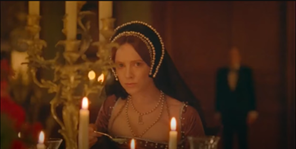
An “upside-down” fairy tale (Kay), Spencer gives voice to the torment of a princess that was hidden from the eyes of the world. It does so through a subtle, yet explicit, use of horror features, style, and references. In an interview for the LA Times, in which the abundant references to The Shining were brought to attention, Pablo Larrain declared that they were “unintentional” and that Kubrick’s film “is just in his bloodstream” (Whipp). In fact, references to The Shining are present in Spencer, and though the two films are very different, the former’s aura permeates the latter from the beginning. Both films open with the protagonist driving to the location where the horror will take place. These opening sequences, made up of dynamic shots from above following the car ride, are both accompanied only by music: the sinister, creepy score by Carlos and Elkind in The Shining; and the sweet and warm, yet melancholic piano soundtrack by Jonny Greenwood in Spencer. Both destinations where the characters are headed represent (or, in the case of the Overlook, actually embody) evil. They are both isolated places in the middle of nowhere. The cinematic parallel, as much as it may be unintended, is evident. Visually, Spencer’s resemblances to The Shining stand out: the gardens and mazes, the interiors of the estates, the fridge and its significance in both films. Similarities are present in the plot too. The horror represented in the two films is of a different kind, yet is very similar. In The Shining, the plot unravels around Jack progressively losing his mind. Differently from what Stephen King had written and intended to deliver, Kubrick wanted the evil to come from within the character, instead of it coming from the haunted hotel. In King’s book and script adaptation, it was the hotel to make Jack lose his mind and attempt to murder his family. In the film, the Overlook, an isolated and alienating location, only seems to bring out something that Jack had within him already, some sort of hate towards his family. Hints of family dysfunction are given throughout the film, from before the characters even get to the place; the horrors are suggested to be there already, the alienating space and solitude are only giving them a way to come out. Similarly, in Spencer, the horrors are present within Diana from long before she gets to the royal estate for Christmas. In this case, the horror taking place is different in the fact that it makes the protagonist a victim, rather than a victimizer like Jack. Diana’s horror is psychological, coming from the pressure of feeling trapped in a cage – a marriage to a man who does not love her, the impossibility of divorce, the suffocating dynamics of belonging to the royal family, the rules, the routine. Though theoretically invisible, the intense uneasiness Diana experiences transforms into an actual physical illness. Similarly, the horror in The Shining is also psychological, as the growing invisible influence of the hotel is driving Jack mad. In fact, both Jack and Diana’s conditions get worse as they spend time in the isolated location. Jack becomes increasingly manic and violent, while Diana’s anxiety worsens to the point of giving her vivid hallucinations. In Diana’s case this is powered by the presences in the house rather than the place itself – similarly to what happens in King’s version of The Shining, where Jack is driven mad by the presences in the hotel. Another interesting parallel is that Diana has hallucinations of Anne Boleyn, a historical figure whose story of beheading by her own husband on the accusation of treason makes the two characters quite similar; likewise, Jack has visions of the previous guardian of the hotel, who ended up murdering his whole family like Jack will attempt to do later in the film. Thus there is a horror legacy present in both films, though it affects the protagonists in two different ways by making one the victim and one the perpetrator. And this is where the horror of the two films differs, which eventually will lead to the two protagonists’ stories taking different directions, while still maintaining a parallel: both films give a happy ending to the victims (Wendy and Danny; Diana, William and Harry) who all manage to escape from the haunted place, where the perpetrators (Jack, Charles) are left.
The second parallel to make Spencer a “horror in disguise” (Sales) is the one between Larrain’s film and another classic of the horror genre, Tobe Hooper’s The Texas Chain Saw Massacre. Here, the similarity is not in the plotline as much as it is in the themes and in their visual translation. Again, the sequence takes place in an isolated house in the middle of the fields in Newt (Muerto County, Texas), where all but one of a group of friends is brutally slaughtered by a family of cannibals. One peculiarity is that in both films, the horror starts taking place in daylight, through action as well as through symbolic cinematic prompts – like the presence of dead animals’ bodies. Through the representation of violence, The Texas Chain Saw Massacre deals with many themes, including the theme of the dysfunctional family. The scene where this dynamic is most explicit is the “dinner” scene, where Sally is tied to a chair in front of a table where the family of cannibals is also sitting down. The sequence is accompanied by Sally’s constant screaming as terror is mounting within her. As she screams, the men taunt her and mimic her crying in a grotesque howling. The sequence is renowned as one of the most haunting scenes of the entire film: the horror depicted is brutal, noisy, and explicit, with shots of Sally’s eyes full of terror, her mouth in the strain of screaming. Under the thematic analysis of family dysfunction, an interesting study of the scene sheds light on the fact that the family is interpreted by the audience as cannibals, but “in their own eyes and through their dynamic interactions they are just a normal family in a setting that’s inherently primitive and dysfunctional, so nothing is technically out of place in their alienated world” (Ryan Hollinger). This interpretation applies to Hooper’s film as much as it applies to Spencer. The internal dynamics taking place within the royal family have only recently begun to come to light. The suffocating rules applying to behavior, appearance, and life in general as a royal, probably started to be questioned by the public only after the release of Lady Diana’s 1995 BBC interview with Martin Bashir, followed by her death two years later. The gap between public appearance and private life is huge. Due to their traditional style of life, the royal family seems to live under a crystal case, in what could be defined as their “alienated world.” Similarly to The Texas Chain Saw Massacre, Spencer presents these dynamics through a dinner scene on Christmas Eve. Though Diana is not tied to a chair, she too is attending a dinner she does not want to attend. The scene is silent; the only sound is the music played by the violins in the room and the sound of cutlery touching the plates. As she is sitting down at the table and everyone starts eating, Diana crosses eyes with Major Gregory, Charles, and the Queen; her vision of Anne Boleyn also appears. Illuminated by candlelight, their haunting looks staring at her, waiting for her to eat, make her feel suffocated. In a desperate attempt to relieve that feeling, she tears apart the pearl necklace she is wearing, the big white pearls falling onto the table and into her soup. Then she grabs the spoon and, bringing a spoonful of soup and pearls to her mouth, she eats. The sequence ends with Diana leaving the room and rushing to the bathroom, the pearl necklace still around her neck. Thus the scene is only figurative, but still quite explicit: eating the soup feels like ingesting pearls. Differently from the dinner scene in The Texas Chain Saw Massacre, the horror Larrain depicts in the sequence is silent, subtle, and internal, but just as disturbing.
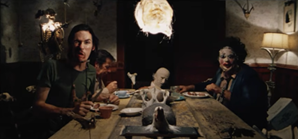
As some critics pointed out, though Spencer is based on real facts, it cannot be considered a biopic. Though Larrain’s representation is incredibly accurate, as many, including Diana’s bodyguard (Bonner), have highlighted, it is true that Diana was not exactly like the film presents her. Spencer gives the audience just a glimpse of her “bright” side through the relationship with William and Harry, the few heartwarming moments they have together, and the ending, which sees the three of them leaving the estate. Apart from that, it focuses on the princess’s “dark side,” and that is where the horror comes out. The references and parallels to two classics of the horror genre in a film that is packaged as a fairy tale not only are fascinating, but also loaded with meaning. Surely Diana’s personality was much more nuanced than what we see from the film, and surely shows like The Crown can give a much more detailed account of the dynamics within the royal family and the reality of being a royal. But what Spencer presents is also a part of that reality, a relevant one that was kept secret for years. Pablo Larrain’s stylistic choices make Spencer a horror fairy tale. The film is uneasiness at wearing luxurious dresses, solitude while sitting at a crowded table, and ingesting pearls while eating gourmet meals – horror dressed up as a fable. If nothing else, Larrain does give the film a happy ending, in accordance with the fairy-tale structure: in the end, Diana is able to take her kids and leave the estate, and the film ends with them eating chicken from KFC – something that would not have happened in real life.
References
Kay, Jeremy. “‘Spencer’ Director Pablo Larrain on Making an ‘Upside-Down Fairy Tale’ About Princess Diana.” ScreenDaily, 8 Dec. 2021, https://www.screendaily.com/features/spencer-director-pablo-larrain-on-making-an-upside-down-fairy-tale-about-princess-diana/5165751.article.
Bonner, Mehera. “Princess Diana’s Bodyguard Saw ‘Spencer’ and Has Some Thoughts.” Cosmopolitan, 12 Nov. 2021, https://www.cosmopolitan.com/entertainment/movies/a38221361/princess-diana-bodyguard-spencer-reaction/.
Hollinger, Ryan, director. “The Art of TEXAS CHAINSAW MASSACRE: Making Daylight Scary.” YouTube, 2 Sept. 2017, https://www.youtube.com/watch?v=6k2HCHfMq0k.
Sales, Michael. “Review of Spencer – The Cinematic Parallels of Spencer and the Shining.” Midlands Movies, 20 Jan. 2022, https://www.midlandsmovies.com/review-of-spencer.
Whipp, Glenn. “Pieces of a Princess: Kristen Stewart and Pablo Larraín Break Down Three Key ‘Spencer’ Scenes.” Los Angeles Times, 5 Nov. 2021, https://www.latimes.com/entertainment-arts/movies/story/2021-11-05/kristen-stewart-spencer-pablo-larrain.
Author Biography
Costanza Chirdo graduated in English and Media from Goldsmiths University of London in 2021. Throughout the course of the degree, she developed her passion for film by writing essays on cinema and literature and screenplays. She is now pursuing a MSc in Strategies of Political and Public Communication at the School of Political Science “Cesare Alfieri,” University of Florence.

